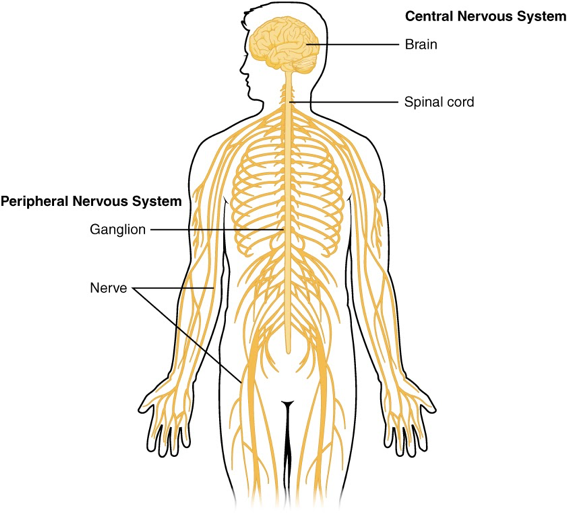Basics: neuroscience and psychophysics
18 The Central and Peripheral Nervous System
Learning Objectives
Understand the layout of the CNS and PNS to support future learning about different sensory systems
Know which nervous system is most likely to heal after injury
The nervous system can be divided into two major regions: the peripheral nervous system (PNS) and the central nervous system (CNS). The central nervous system consists of the brain and spinal cord; the peripheral nervous system consists of everything else. The spinal cord transmits information for the brain to process. The brain is contained within the cranial cavity of the skull, and the spinal cord is contained within the vertebral cavity of the vertebral column. The peripheral nervous system is so named because it is on the periphery—meaning beyond the brain and spinal cord. It is a bit of an oversimplification to say that the CNS is what is inside these two cavities and the peripheral nervous system is outside of them, but that is one way to start to think about it. Depending on different aspects of the nervous system, the dividing line between central and peripheral is not necessarily universal. In actuality, there are some elements of the peripheral nervous system that are within the cranial or vertebral cavities. The peripheral nervous system has been called the power plant of the nervous system. It is like a system that collects information and sends commands. The PNS is also divided into two systems, the autonomic nervous system and the sensory-somatic nervous system. Both will be talked about in more depth later on.

As a general rule, neurons in the central nervous system cannot regenerate or grow back after injury. The most obvious example of this is paralysis after spinal cord injury. Peripheral neurons, on the other hand, often do regrow after injury. For example, after a deep cut on the skin, the area around the cut is often numb for a long time after the cut looks like it has healed. But slowly—after several weeks or months—the sensation comes back. It is not yet known why neural regeneration is so different in the central and peripheral nervous systems, and many research groups who want to help patients with spinal cord injuries or strokes are trying to discover what inhibits growth in the CNS and encourages growth in the PNS (Tsintou, 2020).
CC LICENSED CONTENT, SHARED PREVIOUSLY
Lumen Learning, Anatomy and Physiology I, Basic Structure and Function of the Nervous System
Provided by: Boundless.com.
URL: https://courses.lumenlearning.com/cuny-csi-ap-1/chapter/basic-structure-and-function-of-the-nervous-system/
License: CC-BY-SA
Adapted by: Mari Thompson
OpenStax, Anatomy and Physiology Section 12.1 Basic Structure and Function of the Nervous System
Provided by: Rice University.
Access for free at https://openstax.org/books/anatomy-and-physiology/pages/1-introduction
License: CC-BY 4.0
Quiz by: Anna Zhang
References:
Tsintou, M., Dalamagkas, K., Makris, N. (2020). Taking central nervous system regenerative therapies to the clinic: curing rodents versus nonhuman primates versus humans. Neural Regen Res. 2020 Mar;15(3):425-437. doi: 10.4103/1673-5374.266048.

